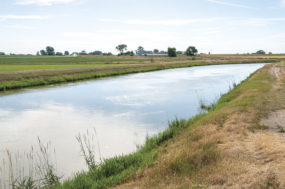The “Arkansas Traveler,” the 1961 Freightliner that was my first diesel truck, was the only truck I owned that used them. They pre-dated cooling fans that ran when needed.
The cooling system on the Traveler was robust. When pulling a steep grade in the heat of summer with the Cummins 220 engine, the road speed would be down in the “I can walk faster than that” range, and the engine needed huge amounts of air through the radiator to keep things from melting down in the heat.
Since the shutters were stuck open, winter operation left me driving with one hand and sitting on the other – and switching hands often. Upon arrival, I thought my backside was frozen.
When I finally got the shutters to close, there was a world of difference. The inside of the cab was warm. The truck had more power and smoked less, and it used less fuel. The big boys told me that those engines needed to be at least 180ºF to run properly.
When radiator shutters were phased out as more robust thermostats and temperature-controlled cooling fan clutches became the norm, winter-fronts were popular for several years. Most trucks these days have an intercooler, which cools the air from the turbocharger to the engine. The intercooler sits ahead of the radiator and, in most conditions, a winter-front that blocks the radiator interferes with its operation.
Trucks aren’t the only thing with tricky operating temperatures. One hay delivery left us finishing unloading just as it became fully zero-dark-thirty. The rancher had written checks for the hay and told us that since we were going to camp there with the trucks, he’d have the hired man’s wife cook us breakfast in the morning. That became interesting.
The lady had just moved into the house, and it was her first experience with an electric range. She couldn’t get her head around the idea that if the heating element wasn’t glowing red-hot, it still may be hot enough to cook on.
The idea of a 100-mile drive that was going to take over three hours to drive to breakfast was not appealing, so we actually appreciated the pancakes that were usually crispy, very dark brown on one side, sometimes both, and a little gooey in the center. We felt that it was prudent to avoid offering any suggestions on how to cook with an electric range.
I was 10 years old before my mother had a cookstove that did not get its heat from wood or coal. Bread, cakes, pies, casseroles, beef roasts, ham and Thanksgiving turkey all seemed cooked to perfection in the oven of the coal stove Mom managed the temperature on by controlling how fast the fire in the firebox burned by use of the damper. Eggs, bacon and pancakes fried on top seemed cooked just right, also.
Operating temperature became important a few years back when we had a major bash over Thanksgiving. One daughter-in-law wanted deep-fat-fried turkey, so the boys and I got set up and deep-fat fried a couple of turkeys. We set up, as directed, outside of the house and away from anything we might set on fire. The directions said to lower the turkey into the grease when it reached a temperature of 350ºF.
Everything went well. The grease boiled and spattered a bit as we lowered the turkey, which was eventually submerged in the boiling oil. When the elapsed time was up, we lifted the bird and checked the internal temperature on the thickest part of the beast. Right at 180ºF – so we placed it on a platter and went for the second bird.
A glance at the thermometer in the oil showed close to 450ºF as we lowered the second turkey. The oil reacted violently, and we quickly pulled the bird back out of the oil. In short order, the oil cooled back to the 350ºF neighborhood, and we cooked the second bird without further incident.
Had we dropped the bird in at the higher temperature, the hot oil would have boiled over, and the propane fire beneath would have ignited it.
Even ice cream has an operating temperature. Ice cream or sherbet keeps best if frozen cold enough that it’s rock-solid. At that temperature, it’s very difficult to scoop. If you put a 5-quart tub of either in the microwave for 30 seconds, it will still be solid but will be readily scoop-able. Individual microwaves and varying container sizes may alter the exact time you need, so be a bright boy (or girl) and experiment on this one when there are no witnesses present.
And finally, as we discuss operating temperature, young men keep this in mind: As you go about having a family, do all you can to avoid having your wife be in the later weeks of pregnancy during the heat of the summer. One lady in August had an appointment to discuss inducing labor.
When she told her husband that today was the day, she let on that the doctor thought they should give it another week, and her husband asked, “Then why today?” She replied, “When he said another whole week, I cried.” ![]()










